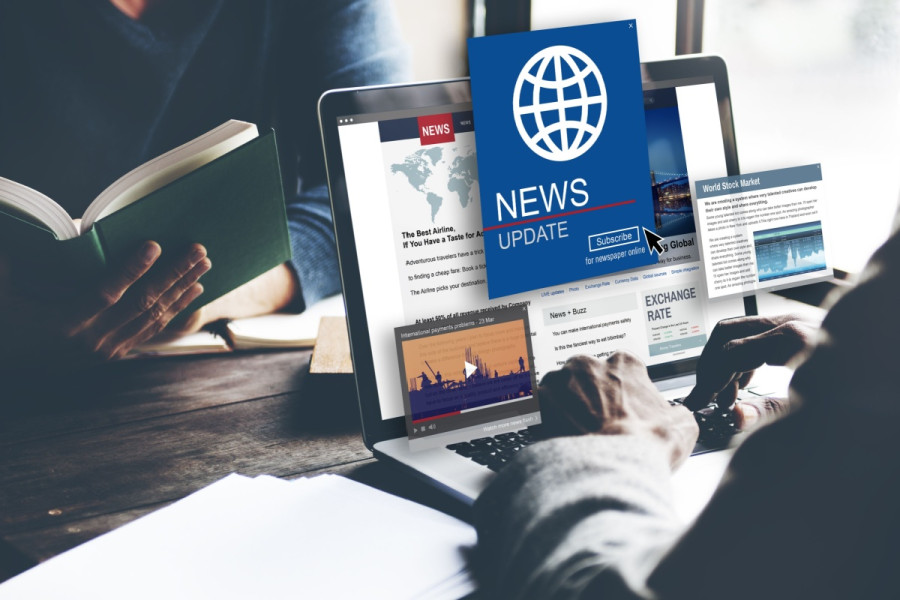Columns
Protecting local media from social media
With a long history, public trust and established principles, journalism is best positioned to provide truthful information.
Ujjwal Acharya
The current discourse surrounding social media regulations is focused on bringing those platforms under legal and taxation framework. However, a critical aspect missing in the efforts to regulate them is how to safeguard our interests around the democratic information landscape and hold them accountable for, or at least make them support intervention to minimise, the problems they may aggravate.
Regulation of social media platforms is a widely discussed topic worldwide. In Nepal, after the Ministry of Communication and Information Technology published the controversial Social Media Bill draft, social media regulation became a buzzword among civil society organisations and media. However, there is a criticism of the bill for not distinguishing between platform and content regulations, and the restrictive nature of the bill that aims to bring social media companies into the local legal and taxation system.
A significant aspect missing in the discourse is how to safeguard our information landscape by saving journalism and local media from giant social media companies. While paving the path for international social media companies to enter Nepal, we must ensure that our national and democratic interests—beyond taxation issues—are well protected.
Local journalism—and, therefore, our media system—is one of the interests which must be protected from social media platforms.
Why protect local journalism?
Local journalism needs protection for two reasons. First, it is integral to a functioning democracy. Second, it is one of the best interventions against the rise of misinformation.
Much of today’s journalism is probably for business, but despite that, media serves the citizens, government and democracy of any country. In a functional democracy, the people have a voice in state matters and choose their representatives, thereby making informed decisions to choose a government. To make that decision correctly, the citizens must have correct information on public matters of the state. The government’s duty to ensure that citizens are served with information on public issues is entrusted to the media. Because of this role, the state supports and provides special protection and facilities—such as elevated rights to seek information and movement or equipment and papers on subsidised rates—to the media.
For democracy to be functional, the people in power should be accountable. The media is also responsible for bringing accountability into play and questioning the decisions and roles of those in power. The media also serves as a platform where matters of public interest are critically discussed and debated. All these serve democracy’s purpose by strengthening public participation.
The current information ecosystem is messy, especially due to the unprecedented rise of misinformation. Its spread is the greatest threat to humanity, according to the World Economic Forum’s Global Risks Report 2024. The abundance of fake information in the public sphere means there will be false discourses and fake debates; it can elect the wrong people to significant positions and may misguide the citizens on important issues. In the words of an Indian journalist, Ravish Kumar, “fake debates result in fake politics… It is a means to take the focus far away from the real problems that affect people.”
The best antidote for misinformation is correct information. With a long history, public trust and established principles, the media is best positioned to provide truthful information to the public. Therefore, in the struggle against misinformation, an important invention—probably the most important—is strengthening local media by helping them foster business, ensuring fair competition for media pluralism and facilitating their rigorous content production.
Does it kill local journalism?
Countries like Australia, Canada, and others have introduced laws requiring social media platforms to pay the media to use their news. Such laws were passed with the understanding that those platforms were benefiting from the news—in which they hadn’t invested anything—while media paying for the production of that news are struggling to survive. This lopsided cycle will ultimately kill the media.
This could happen in developed countries whose media contents were used by the social media platforms in their ‘news’ features, such as the now depreciated news tab on Facebook or Google News. The situation is different in Nepal. Although social media may indirectly benefit from the news shared over the platforms, our media are looking at those platforms as enablers to reach more audiences, thereby creating a name and impact that they hope to use to convince local advertisers to invest in them. Many local media houses have profited from this approach as advertisers have yet to move completely away from them.
However, more advertisers are migrating to social media. Advertising data from Meta shows that Nepali advertisers spent Rs1.3 million per month on average on Facebook advertising in the last one and a half years. The amount itself isn’t sufficient; however, this is just the amount spent on one social media platform, whereas many Nepali advertisements are on several other social media platforms. The possibility of microtargeting an audience at the cost unimaginable to advertise on mainstream media draws not only small businesses but also is a lucrative offer for big businesses.
It is safe to assume that the advertising expenditure on social media platforms will increase manifold if the social media platform regulations are implemented as they are in the current draft. With laws, we are paving ways for these social media platforms to operate businesses and take big chunks of advertising money, paying a portion of it as taxes. However, a big chunk of our advertising money will be insufficient for the social media platforms. Therefore, they are unlikely to invest in strengthening the information ecosystem. However, it may bring us a situation where local journalism is nearly extinct and social media platforms would do nothing to solve the problem of misinformation.
In the Indian elections, some organisations have accused big technology firms of not taking any action “despite evidence of rampant hate speech, misinformation, and political bias” and that “social media platforms like Facebook, YouTube, Instagram, WhatsApp, and Telegram are allowing trolls and propagandists to spread hatred, division, and lies in society”.
What the state can do
There are at least two things a state like Nepal can do: Ensure strengthened local journalism and a balanced social media regulation mechanism to sustain the integrity of the information ecosystem.
Lawmakers in many US states have introduced bills to protect local media in the wake of the financial crisis they are facing. According to Jessica Mahone, the research director for the Centre for Innovation and Sustainability in Local Media at the University of North Carolina at Chapel Hill, between 2017 and 2022, lawmakers in 10 US states introduced legislation to provide support to local news organisations proposing four mechanisms: Tax incentives, general funding, establishing a task force or commission and allocating a proportion of a government’s advertising budget. Apart from these measures, Nepal can strengthen journalism and media through content production, skill development and marketing.
It's also imperative that social media regulations not only allow social media to enter but also ensure they are accountable for problems such as the spread of misinformation or hate speech. This may be achieved by requiring them to spend substantially to help local institutions and citizens fight against such evils.
It may also be worthwhile to consider implementing rules that require advertisers—except those small ones which cannot advertise in mainstream media—to spend a certain percentage of their advertising budget on local media. For our democracy to function well and be protected from threats brought about by social media, we must ensure that our social media regulations are proper and protective of our interests.




 11.12°C Kathmandu
11.12°C Kathmandu













%20(1).jpg&w=300&height=200)

